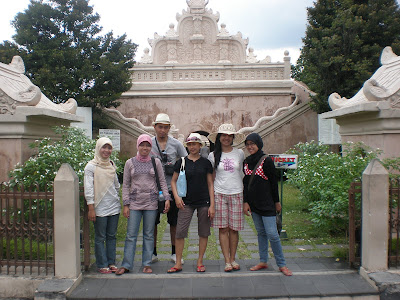Taman Sari Taman Sari Yogyakarta or Yogyakarta Palace is a site of the former park or garden palace (royal garden) Yogyakarta Palace. This can be compared with the Bogor Botanical Gardens Bogor Palace gardens. This garden was built in the days of the sultna hamengku buwono I (HB I) in the years 1758-1765/9.
Originally, the garden that gets the title of "The Fragrant Garden" has a total area of more than 10 hectares, with about 57 buildings such as buildings, swimming baths, a suspension bridge, canal water, and artificial lakes and artificial islands and an underwater tunnel. Garden used effectively between 1765-1812 was originally stretched from southwest to southeast Kedhaton complex Magangan complex. But today, the remnants of the Taman Sari, which can be viewed only in a complex southwest Kedhaton only
That said, Taman Sari was built in the former palace of old, Pesanggrahan Garjitawati, which was founded by His Majesty Pakubowono II as a resting place that will train a horse go to Imogiri. As a leadership development projects instituted Tumenggung Mangundipuro Taman Sari. The entire development cost borne by the Regents of Madiun, Tumenggung Prawirosentiko, along with all people. Therefore exempt from Madiun district tax levies.
In the midst of the leadership development project was taken over by Prince Notokusumo, after Mangundipuro resign. Although officially a royal garden, but the existing building and keeping indicates Taman Sari serves as the last bastion if the palace was attacked by the enemy. It is said that one of the architects of this garden was a Portuguese royal better known as the Demat Tegis.
Taman Sari least complex can be divided into four sections. The first part is an artificial lake which lies to the west. The next section is a building located in the south of the artificial lake, among others Baths Umbul Binangun. The third section is Pasarean Ledok Sari and Swimming Garjitawati located in the southern part of the second. The last section is the section east of the first and second section and extends eastward to southeastern Magangan complex.














 9:45 PM
9:45 PM
 tata
tata

 Posted in
Posted in

















0 comments:
Post a Comment